|
|
 |
 |
|
Christchurch and District Model Flying Club
Sloping Off - our newsletter
|
 |
 |
|
BEFORE I FORGET, BY KEN SPOKES
Part 4 of 5
|
 |
 |
|
- Pictured, is RC flying early fifties style.
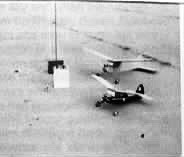
- The front model is a friend’s Vic Smeeds “Popsie”, the other, my ”Citizenship” Both have just rudder control.The transmitters are an ED (back) and my home brew The Citizenship acted as my test bed for future experiments and lasted by some miracle for several years, It met its end flying on Epsom Downs when the wings folded at a few hundred feet.The crash was quite spectacular. Flushed with success, I felt a bigger and better model was needed and built an Eros powered by an Eta 5 diesel motor and equipped with a multi-step actuator which would give both elevator and rudder control. The model was completed apart from covering but sadly never took to the air becoming a casualty in the move to London.
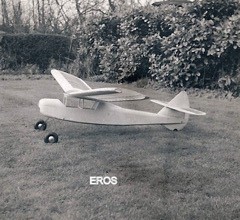
- As more and more modellers got involved in R/C many improvements and ideas were regularly published. The radio became more reliable and the range increased but still used valve technology and the need for heavy batteries to power both transmitter and receiver. It was still essentially a single channel system. The actuators became more complicated and in response to coded on/off transmissions could give additional up or down elevator. Movement of control surfaces were still full-on or full-off and many attempts were made to provide proportional movement. One such system was called "Galloping Ghost - it was very simple and worked by the transmitter being switched on and off several times a second By means of left - right and up - down joysticks ,both the switch ratio and the switch frequency could be varied. In the model, a geared Mighty Midget motor was switched in forward and reverse directions by a receiver relay contacts responding to the transmitted signal. The geared motor output shaft was coupled to the rudder and elevator which pulsed to the right or left or up and down depending on the pulse ratio and pulse frequency, respectively .Further refinements were added to control the motor or some other function by switching to full signal or off for a couple of seconds. It worked after a fashion, but didn't really catch on.
-
- By the mid to late 50s transistors became commercially available and totally transformed the R/C scene. They replaced the valve and the need for heavy batteries with the result that both the transmitter and receiver became much smaller, rugged and lighter. Consequently, models could be built smaller and hand held transmitters became possible. Also, printed circuit boards were replacing hard wiring and rechargeable batteries replacing primary batteries. These were called Deacs and could occasionally explode .My son, Dave, built a Deac powered electric hovercraft which performed very well until one day as it was scudding across the lawn, it suddenly blew up - most spectacular but not quite what he had expected.. We were very wary of using them after that episode but fortunately had no repeats .
-
- At this time we were living in Morden, South London. We bought our first car, a Standard Vanguard
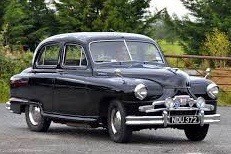
- and were now able to visit the flying site on Epsom Downs This was the venue for flyers from all over the area where on any day and particularly at weekend models of all types could be seen. Although further away, the old Croydon Airport was an excellent alternative site when flying was not allowed during race meetings. An R/C model was still a rarity and always attracted a crowd who were frequently entertained by a crash or a flyaway. Model building was very much a secondary activity at this time being a means of getting our home-built radio equipment airborne. Vic Smeed’s “Ethereal Lady" nicknamed Ethel
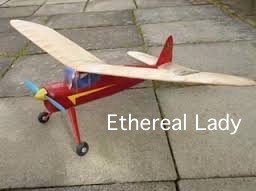
- was such a hack and also Keil Kraft's Super 60. By now, Dave was keenly interested in RC and together we were building many of the projects featured in the model magazines. We built a multi channel reed based system which worked but was so temperamental that we considered it unsafe to instal in a model. The only such system I ever saw being flown was on Epsom Downs by an American Serviceman. It was fascinating to watch how the bank of switches on the transmitter were flicked and pulsed. Crude but amazingly effective and must have taken a great deal of practice to master the art.. I think we were wise not to have gone further down that path.
-
- Several times on our visit to the Downs, I had the pleasure of meeting P E Norman and his son Marcus and chatting about his pioneering work with ducted fans, encapsulated receivers.and pendulum control. Sadly he died of a heart attack while flying there one day. By now we were flying reliable single channel models using a mix of home brew and commercial gear. Mcgregor single channel transmitter and receiver worked well with Elmic actuators. Radio control flying at this time was essentially steering a “ free flight” model around the sky and when the fuel ran out, hopefully landing nearby. Flights usually lasted little more than five minutes. Care had to be taken to put the right number of turns on the escapement rubber band for each flight - too few and control could be lost when it wound down - too many and the actuator could stick or skip. All sounds very dicey but it worked and was surprising how much control could be achieved by just single and double blipping of the press-button switch.
-
- Model covering materials were traditionally doped Japanese tissue for small models and silk for the larger ones. Tissue covering was light and easy to apply but was much prone to damage. Repairing rips and punctures was almost certain to follow a flying session. Areas around the engine bay had to be fuel proofed . However, in the 1960s that was all about to change with the introduction of a heat shrink plastic covering from the USA. The first was Monocote which was expensive and soon dubbed Moneycote. It was rapidly followed by UK makes such as Solarfilm and the price tumbled.. Once the technique of applying had been mastered it offered a tough fuelproof finish in a wide range of colours without the need to dope or paint.
- Somewhere about this time, a neighbour gave me a box of old model aero engines that had belonged to her son who had left home and no longer wanted them. They were mostly early diesels and in poor condition but with a lot of TLC became very presentable. From this beginning, I began a collection of antique model aero engines which eventually built up to fifty or sixty in number and included a several pre- war spark ignition engines My workshop by now included a Hobbymat lathe and miller which enabled me to restore a number to full working order but most were just for display.
- Meanwhile, back in the real world, working in the Engineer in Chief's Office was becoming less attractive by the day as very little engineering was involved and what there was, was repetitious. Also,the seniority list seemed to stretch to infinity with little prospect of promotion for many years. I began looking for a way out and as luck would have it, the then Ministry of Transport and Civil Aviation were advertising for main grade engineers. I applied, was interviewed and was fortunate to be accepted. Hooray, I went up a pay grade, no longer went to the office on Saturday mornings, and would be working with aeroplanes - or so I thought. Initially, I joined a section responsible for the procurement and installation of ground based radio navigation aids - a whole new world of Non Directional Beacons(NDB), VHF Omnidirectional Ranges (VOR) and Instrument Landing Systems (ILS). It was interesting work with an occasional seat in the Ministry De Havilland Dove making calibration flights.
- Twice a year during the slack winter months, we were encouraged to make Familiarisation flights with BEA. The idea was that given a cockpit pass we would spend time with the crew and experience how ”the other half” lives.The only proviso was that the journey out and back should take place within the day and subject to a spare seat being available.This led to much perusal of Airline Schedules to maximise the time spent at the destination and often meant a departure at some unearthly time of the morning. My first flight under this scheme was particularly memorable as it was the first time I had been abroad and the first time that I had flown in a passenger plane. My destination was Rome and the flight out was in an Ambassador departing just after midnight.
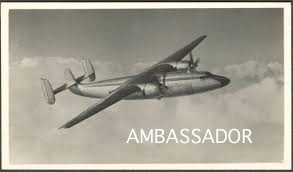 - There were only a handful of passengers on board and after we had taken off and given a boiled sweet, it was announced that there was a problem with the heating system. The cabin soon became bitterly cold but seemingly not as cold as the cockpit which when I made the mandatory visit was covered in hoar frost with the pilot and co-pilot hunched in heavy overcoats. The only redeeming feature was looking down on the snow covered Alps bathed in moonlight. I spent the day dodging rain showers and taking in as many of the sights as possible. The trip back was mid -afternoon and I was not looking forward to another flight in the Ambassador.
- However, much to my delight I found myself boarding a brand new Vickers Viscount. The contrast could not have been greater. Here was a state of the art aircraft. It was comfortable and warm with large picture windows and oh so quiet. With an hour spent on the flight deck, it was a wonderful flight home.
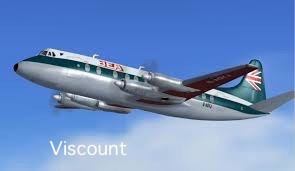 - We also had an arrangement with BEA for staff to carry out limited training on their flight simulation facilities. This involved “flying” the Link Trainer together with sessions observing flight deck procedures in the cockpit simulator where all manner of emergencies would occur during a “flight” lasting several hours. This was incredibly realistic and the crew were quite exhausted at the end of the exercise.
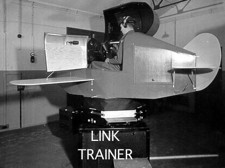 - An interesting diversion came my way which had nothing whatsoever to do with my work with navigation aids. Apparently, there was an increasing need to improve communication with North Atlantic air traffic by means of teletype but little information was available regarding the reliability of transmissions on the intended radio frequencies...As part of a data gathering exercise, arrangements were made with RAF Gibraltar and Reuters in Tangier to monitor reception over a period of several weeks. My job was to take out receiver equipment, install it and log the results on a daily basis. I’m pleased to say that I had every help and cooperation from the RAF personnel stationed on The Rock including a visit to the top. Once everything was set up and working, I took the opportunity to visit Tangier and the impressive Reuter radio station on the Atlantic coast The trip over was in a DC3 of Moroccan Airways when I was severely admonished by a member of the cabin crew for taking pictures of the North African coast. They confiscated the film but fortunately not my camera. No idea what that was all about but I decided to return to Gibraltar by ferry.
- Again during the 1960s radio control transmitters and receivers were now becoming very reliable being crystal controlled, using printed circuit boards and solid state components. Transmissions were still in the 27Mhz band with five colour coded channels allotted. These were now available commercially and in kit form or DIY based on details published in the new RC magazine, RCM&E.
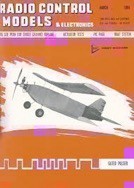 - Single channel was still the main method of control .Aerobatics were rarely seen and such attempts were restricted to users of exotic “bang-bang” systems, reeds or “Galloping Ghost” However this was all about to change as we began to hear that true proportional systems had been developed. Magazine reviews informed us that with multi- channel sets at least four control functions such as rudder, elevator, aileron and motor throttle could all be moved in sympathy with joy sticks on a hand held transmitter. Now for the first time, models could be truly flown like the real thing- a dream come true. Until this time, RC aircraft were typically high-wing cabin models that were very stable and most likely had originally been designed for free flight. Now a new range of models began to appear designed to take advantage of the superior control this new system provided. Aerobatics and precision flying became popular and attracted many flyers who were only interested in this aspect of the hobby.
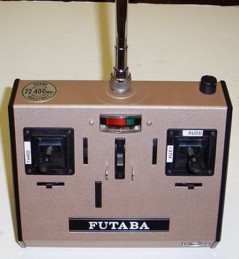 - I bought my first proportional set in 1969.which had four controls and was manufactured by Futaba. It came complete with rechargeable batteries,, chargers and crystals and coloured pennants for each of the five channels available at the time. The servos were unusual in that the output arms were push-pull rather than rotary as is the standard today .It was very basic with no “bells and whistles”. Setting up a model was achieved by adjustments in the model itself .There was no servo reversal for example so consideration had to be given to how these should be installed in the model during construction. The receiver and servos were about the same weight as gear used today. ( 2.4Ghz receivers excepted) My set was very reliable, had excellent range and the only problem I encountered was occasional interference much later from CB. This however ,was effectively countered in 1981, by the introduction of new R/C frequencies in the 35 Mhz band. Signal modulation techniques were also introduced to combat interference. Models had previously been powered by diesel engines but now glo engines were becoming popular and available in a range of sizes. These were powerful and had excellent speed control but were much noisier than diesels requiring silencers to be fitted. Fortunately most came with an effective silencer The flight box now became a serious piece of kit with its glo plug driver, electric starter, tachometer, fuel pump,12 volt battery and fuel container together with frequency pennants,crystals spare props,glo plugs, cleaning fluid and tools - not forgetting the radio transmitter. All this was so heavy that it was often fitted with wheels for easy transport.
- For some time now, my models had been mostly a means of getting home made RC gear into the air. However, the bought R/C systems were so good that there seemed little point in continuing with that side of things and instead, I began to concentrate on building models with good flight performance. The Kwik Fly and Gangster were two of my favourites .
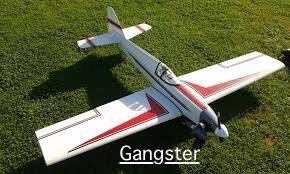 - They both had a 60” wing span and fitted with a Merco 60 could perform most of the basic aerobatic maneuvers. Learning to fly using a propo system was quite a challenge and certainly not as easy as I thought it would be. Having only been accustomed to just rudder control, the addition of elevator and aileron tended – intentionally or otherwise to put the model in unfamiliar situations which were frequently difficult to correct. Alsomodels were flying much faster giving less time to make corrections.Things were fine when the model was flying away from me but it was a different matter when the model was coming towards me and the controls were “crossed” As my flying improved, I found that flying left hand circuits were far easier and more relaxing than right handed ones which I tended to avoid. Despite many flights trying to master this problem, I am still not one hundred percent comfortable flying to the right. .What would I have given for a good instructor with a Buddy Box facility? It was all very much trial and error with flying sessions more often than not, ending with some sort of damage. I became quite an expert at making repairs, which for some perverse reason, I quite enjoyed.
- Eventually, I felt that I was a reasonably competent pilot but could never match the level of skill of the more gifted flyers particularly some of the younger ones. We had now moved from Morden to Tadworth just five minutes from the Epsom Race Course which was a wonderful place to fly with wide open spaces and a magnificent view over London. This fact didn’t influence the move which was purely coincidental. Honestly! As it was so good and with easy access, it attracted not only RC flyers but Stunt Kite enthusiasts, freeflight modellers ,and control liners. Flying during the week was fine but weekends were chaotic with so many flyers and lookers-on that it really was unsafe to fly and if possible, was to be avoided. Flying was restricted to the hours between noon and eight pm to reduce noise complaints. Ironically, there always seemed to be a flat calm at eight pm. After an evening’s flying, the ploy was to take off a few minutes to the eight pm deadline and climb as high as possible then switch off the engine and perform dead stick aerobatics on the way down before landing on the strip.
- Again, with the arrival of the aerobatic model, construction techniques were adapting to the need for a more robust airframe. The sheeted “D box” wing became almost a standard feature as was foam cores and resin cowls and parts. I tried making foam wing cores a couple of times with moderate success but preferred built-up with full or partial balsa sheeting. Building radio controlled models also became a lot easier as all the accessories needed were becoming commercially available whereas previously they had to be hand crafted.
- I was a member of the Epsom Flying Club which had sixty or seventy members and held regular meetings, often with guest speakers. I remember Mick Charles, David Boddington and Dr Jeremy Shaw from the LMA giving interesting talks. The Club flying field was at the foot of Box Hill and was not particularly good, bounded on the south side by power lines and a railway with the added hazard that light aircraft tended to follow the hill line occasionally at altitudes lower the our models. Noise complaints by nearby residents forced its closure. Happily, a new site was found at Newdigate which I gather is still in use today.The club at that time was very competition minded both for power models and gliders and was well supported for all events such a timed aerobatic schedule, limbo, timed “touch and go” and spot landing One of the members had built an excellent electric winch which was used for most glider competitions. I found it easy to use and preferred it to a bungee launch Three gliders I was flying at the time was a 100inch span “Tri-Tri” a “Bird of Time” and a twelve foot span “Challenger” designed by Otto Heithacker.
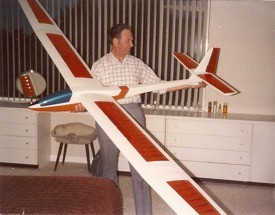 - This model had a long list of competition successes in America and had an outstanding performance. Flying one day from Box Hill ,it was thermaling nicely when I had that horrible feeling that I was no longer in control. Still climbing , it drifted out of sight over the hill. Being such a large model I tried not to imagine what might happen when eventually it landed. My anxiety ended a couple of days later when I heard that it was perched in a very tall tree in Lord Roben’s garden five or six miles away.. As the Chairman of the NCB at the time, he had pulled a few strings and got the local fire brigade to retrieve it with the aid their tall ladders, Seems Lords have their uses! Luckily, it had suffered little damage or perhaps more significant, caused no damage to property or person. The cause of the flyaway turned out to be a duff receiver battery. The use of electric power for model aeroplanes was discussed in the model press from time to time but the general opinion was that it would never be a serious alternative to the IC engine,.While the ducted fan simulated jet propulsion, the possibility of using a true model jet engine was only a dream Experimental helicopters were occasionally featured, but again, it was not foreseen that they would be a real practicality. How things would change in the next few decades
- Final part next time - Ed
|
|










